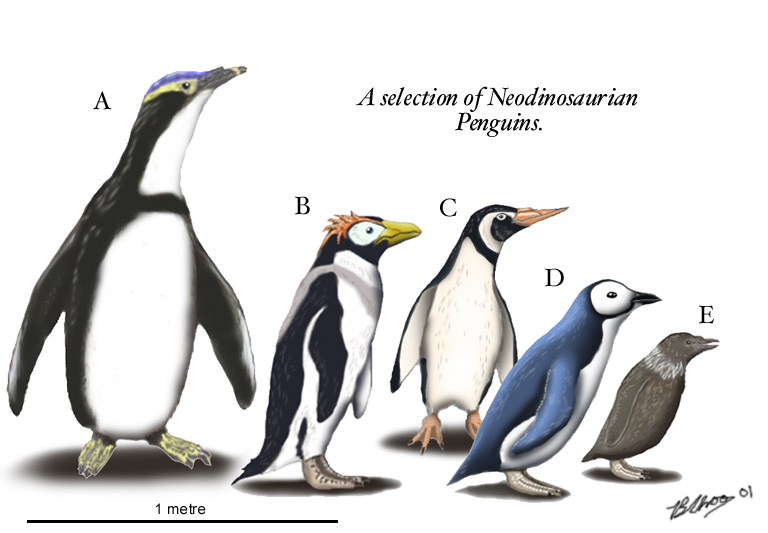
EUORNITHES
Birds are, of course, extremely abundant on land, but it is the oceans that harbor the full gamut of avian diversity, from the gargantuan mega-penguins to the minute terns to the toothed, lobe-footed hespeornithformes
(Text by Daniel Bensen)
SPHENISCIFORMES

Penguins ply the southern seas of this timeline and ours and are known as Eocene fossils from both worlds. This would suggest that the Sphenisciformes had already appeared by the end of the Cretaceous or that presence/absence of the K-T event had little impact on the evolution of penguins, probably on small islands in the New Zealand archipelago. However, in addition to familiar penguins, the neodinosaurian Sphenisciformes include a far greater variety of body forms, some of which include the largest of all avians.SPHENISCIDAE ("normal" penguins)SAMPLE TAXA:
The diversity of Neodinosaurian penguins is slightly greater to that of Home-Earth. Several species inhabit estuarine or even freshwater habitats. Unlike our penguins, some species still retain procellariform-like tube nostrils.(Text by Brian Choo)SAMPLE TAXA:
- A. Padishah penguin
- B. Silverband hawfinch penguin
- C. Greater swordbill penguin
- D. Blueback penguin
- E. Brown penguin
MEGAPINGUIIDAE
The megapinguiidae are large, generalised seal-like forms of the South Polar seas. As penguin body size and flipper musculature became more massive, bipedal waddling became impractical and most of the larger sphenisiforms (Megapinguiidae or "megapenguins") clumsily drag themselves on their bellies using their powerful flippers in the same manner as sea-turtles. This method of locomotion makes them extremely vulnerable on land, thus the megapenguins only breed in the most remote localities including oceanic islands and the Antarctic ice shelf.
SAMPLE TAXA:
- Elephant Teal
MORTIPINGUIIDAE
The penguins of death are large, predatory sphenisciforms with powerful, serrated beaks that rampage across the Antarctic and Southern Temperate oceans. They tackle large carcasses in a manner similar to a crocodile's "death-roll", latching on with their beak and rotating their entire body.Penguins of death are monogamous breeders. The female has a small marspuial like pouch near her hindlimbs where the single egg is incubated. During this time, she has to lie on her side or back to avoid crushing the egg. The hatchling is initially nourished on secretions within the pouch before being fed on regurgitated food brought back by both parents.
SAMPLE TAXA:
- Giant penguin of death
AVISERPENTIDAE
The aviserpentids are medium-to-large sphenisciforms closely allied to the megapinguiids with elongated neck vertebrae. Most of this family are nearshore forms.
- Monarch aviserpent
Red-faced aviserpentHESPERORNITHIFORMES
Back to SpecHesperornithiforms, the sea parrots and seaguins, most likely evolved during the Cretaceous and are the only group of toothed birds which have survived to the present day. Throughout the intervening time between the clades inception and the present day, the hesperornithiforms have proven quite conservative, and their basic body type has changed little.SAMPLE TAXA:A hesperornithiforme resembles nothing so much as a loon stretched and then flattened. These creatures lack the wings of their cousins, the modern birds, and indeed, their foremost appendages have been reduced to jointless paddles. Seaguins' propulsive force is applied by the two hind legs, which are stoutly built, and end in enormous, lobed, feet.
Hesperornithiforms once enjoyed a planet-wide distribution, but by the end of the Mesozoic, they were already withdrawing from the South. Now, due to competition from mosasaurs and modern birds (see above), these creatures are entirely relegated to the Northern Hemisphere, and only really successful around the Arctic.
Sea parrots and seaguins rarely venture onto land, but are forced to make the excursion, periodically, to give birth. These birds are ovoviviparous, but their young are born still encased in the sack-like allentois, and would suffocate in an underwater birth. Thus, seaguin females must climb up onto the land, propelling themselves with sweeps of the feet and a snake-like wriggling of the body, lay their "egg" and then pull the chick free of the confining birth membrane. Further elaboration of this process varies from species to species.
MAREPSITTACINAE(Text by Daniel Bensen)
Unlike the seaquins (see below), sea parrots have retained the teeth in their upper jaw. Based on this character, sea parrots are believed to have diverged from the seaguins in the Eocene or early Miocene.(Text by Matti Aumala)SAMPLE TAXA:Sea Parrot Walrooster
CALCITRONINAE
Using these feet as paddles, the seaguins scull through the water in quick, jerking motions, mimicking the behavior of the squids and ammonites that are their traditional food.
(Text by Daniel Bensen)Blueflank Seaguin Emperor Seaguin Hylekki